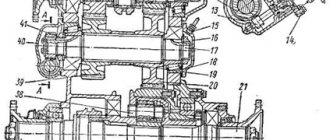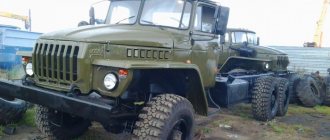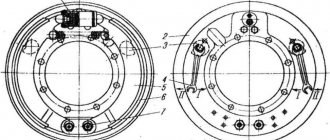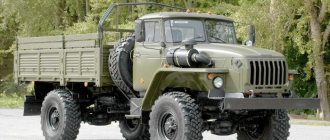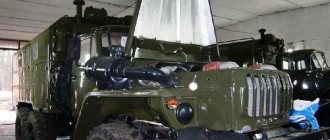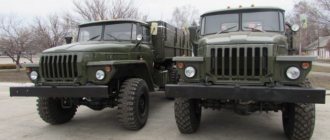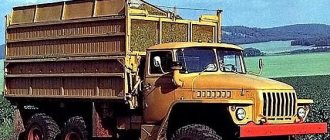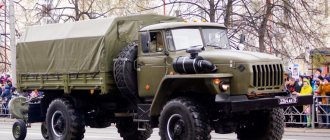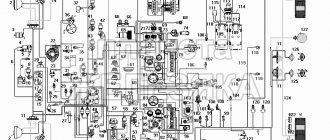The URAL-4320 vehicle is equipped with a two-stage transfer case with an asymmetrical cylindrical center differential lock and a mechanical drive. Transfer case ratios in first gear are 2.15, in second gear - 1.3. The box is attached to the car frame on four rubber pads. The general structure of the transfer case (Fig. 112) of this vehicle is the same as that of the KamAZ-4310 vehicle.
Rice. 112. Transfer case of the URAL-4320 car : 1, 22, 37 - flanges; 2, 10, 16, 25, 33, 40 — bearing caps; 3, 18 — tapered roller bearings; 4, 39 — top gears; 5 - bushing; 6 — top hatch cover; 7 — gear clutch; 8, 20 — low gears; 9 — transfer case housing; 11 — primary shaft; 12 — speedometer drive gear; 13 — driven gear of the speedometer drive; 14 — speedometer sensor flange; 15 — fitting of the sealing system; 17 — intermediate shaft; 19 — spacer sleeve; 21 — rear axle drive shaft; 23 — oil removal ring; 24 — bearing nut; 26 — rear differential bearing housing; 27 — rear differential race; 28 — lower shaft gear; 29 — crown gear; 30 — sun gear; 31 — front differential race; 32 — differential lock clutch; 34 - bolt; 35 — flange reflector; 36 — front axle drive shaft; 38 — satellite; 41 — bearing nut
The crankcase is cast iron, one-piece, and has a hatch on top that is closed by a lid with an oil guide tray.
Oil is poured into the crankcase through the top hatch with the cover removed or through the hole under the control plug located on the rear wall of the crankcase. The oil is drained through the lower hole, closed with a plug with a magnet. Crankcase ventilation is carried out through a fitting, the tube of which is included in the general sealing system of the units.
The drive shaft rotates on two tapered bearings installed in the crankcase and covered with covers. Metal shims are placed under the front bearing cover, and an oil seal is installed in the cover. Power can be taken from the rear toothed end of the shaft when an additional power take-off box is installed on the vehicle to drive the winch. The gears of the second and first gears are mounted on bronze bushings. Between the gears on the shaft splines there is a gear shift coupling. To supply oil to the gear bushings and their teeth, there are holes on the shaft and gears.
The intermediate shaft also rotates on two tapered bearings closed with blind caps; Metal gaskets are placed under the back cover. The gears are mounted on the shaft with splines. At the front end of the shaft, the speedometer drive gear is mounted on a key; the driven gear is located in the boss of the bearing cap. The driven gear drives the speedometer sensor.
The center differential consists of: a carrier with a drive gear, a sun gear, an epicyclic gear, and four satellites. The carrier is composite; it includes front and rear races connected to the drive gear; in addition, a support washer is attached to the front race.
Rice. 113. Control of the transfer case of the URAL-4320 car : 1 - differential lock lever; 2 — gear shift lever; 3 - preload spring; 4 - roller; 5 — bracket and engine mounts; 6, 7 — thrust; 8, 9 - leashes; 10 — bracket for leashes; 11 — gear shift fork rod; 12 — differential lock fork rod; 1 - differential unlocked; I - differential locked; P-front position (second gear engaged); N - middle position, neutral, 3 - rear position (first gear engaged).
The transfer case control drive is mechanical (Fig. 113). It consists of two levers 1 and 2, two rods 6 and 7 with forks, two leads 8 and 9 with bracket 10, two rods 11 and 12 with forks and two clamps. Differential lock lever 1 and gear shift lever 2 are installed in bracket 5 on a common shaft 4. Bracket 5 is also the upper right bracket of the rear engine mount.
Transfer case operation. When engaging first gear, the driver, using lever 2 and drive parts, moves clutch 4 (see Fig. 112) back and connects gear 5 to the drive shaft.
The torque is transmitted through gears 5 and 13 to the drive gear 24 of the differential, in which it is distributed between shafts 28 and 14 in a ratio of 1:2.
In second gear, clutch 4 connects the drive shaft to gear 1. Torque is transmitted through gears 1.32 to the intermediate shaft and through gears 13 and 27 to the differential.
It is necessary to switch the transfer case from second to first gear only after the car has come to a complete stop.
Development history
The need to create a new vehicle based on the Ural-375 three-axle all-wheel drive truck arose soon after the start of production of this model in 1960. The main drawback of all the first modifications of this car was the extremely voracious gasoline engine, which consumed about 50 liters of expensive high-octane A-93 gasoline per 100 kilometers.
At the same time, the design of the car itself was considered quite reliable and efficient. The essence of the upcoming modernization was to replace the gasoline engine with a diesel unit, which consumes simpler fuel and, if possible, is economical. Engineers at the Ural Automobile Plant began independently developing such an engine, but in the end, at the level of industry management, it was decided to transfer this process to the Yaroslavl Motor Plant (YaMZ).
In 1969, YaMZ specialists introduced a new diesel engine in combination with a gearbox for a car based on the then main Ural-375D model. But the first versions of the new vehicle did not show the performance characteristics (tactical and technical characteristics) required primarily by military customers, and after a series of tests that lasted for several years, serial production of the Ural-4320 model began in 1977, and based on the KamAZ engine that had appeared by that time -740.
However, during the preparation of the new model for production, the specialists of the Ural Automobile Plant were able to achieve a high degree of unification of vehicles of the Ural-4320 family with the units and structural elements produced at home. At the same time, any serious modifications to the design of the machine turned out to be minimal.
Basic information about the transfer case of the Ural 5557 and 4320
The Ural 4230 and 5557 vehicles use a two-stage transfer case equipped with an asymmetrical cylindrical center locking differential with a power drive. The transfer case is mounted on the car frame using four rubber pads. The design of the transfer case of the Ural 5557 and 4320 is absolutely the same as that of the KamAZ 4310.
In the middle of the crankcase the following are located on bearings:
- Intermediate roller with gears of the lowest high gear;
- Rear drive shaft with middle axle. An asymmetrical cylindrical center differential is installed on these rollers;
- Front axle drive shaft;
- The primary roller has high and low gears, and a clutch is installed between them to change gears.
In order to maintain atmospheric pressure in the crankcase cavity, a fitting with a tube is installed on the bearing cover, connecting the crankcase to the atmosphere through a sealing system. The outlet tip of the tube is brought to a level above the maximum fordability to prevent water from being sucked into the crankcase while overcoming water obstacles.
The crankcase is made of cast iron, there is a hatch on top, the crankcase itself is one-piece, closed with a lid with an oil guide tray. Oil is poured into the crankcase through the top hatch with the cover removed or through the hole under the control plug, which is located on the rear wall of the crankcase. The oil is drained through the bottom hole, which is closed with a plug with a magnet. The crankcase is ventilated using a fitting, and its tube is included in the general sealing system of the units.
Transfer case Ural 4320
How does the transfer case Ural 4320 and 5557 function?
In the Ural 4320 and 5557, the torque supplied to the drive wheels can change. That is, the transfer case is considered at the same time an additional gearbox, which increases the number of gears and the limits of change in the gear ratio in the transmission. Thanks to the inclusion of a low gear in the gearbox and transfer case Ural 4320, 5557, it is possible to overcome high resistance to movement and stable movement of the machine at low speed.
User manual
Regulatory documentation relating to the operation, maintenance (MOT) and repair of Ural 4320 model trucks notes the versatility of this vehicle (transporting people, cargo and towing trailers), as well as its ability to operate on all types of roads in any terrain. The range of ambient temperatures for which the vehicles were designed was quite wide and ranged from plus 50 to minus 50 degrees Celsius.
In addition, the operational requirements reflected the very high reliability parameters of the Miass truck. If the initial maintenance for a new car usually required 1000 km of run or 50 engine hours, then subsequent maintenance was carried out after 4 thousand km or 125 hours of engine operation, and a more in-depth one - at four times higher rates. Moreover, most maintenance items boiled down to tightening nuts, cleaning, etc. operations.
Design and operation of the transfer case Ural 4320 and 5557
Today we will talk about the transfer case of the Ural 5557 and 4320, and also discuss their design.
The transfer case is a unit that is responsible for distributing torque from the engine to certain drive mechanisms, and they most often increase the number of gears in the transmission.
The Ural transfer case distributes torque between the axles and increases the torque of the drive wheels, which guarantees stability while the Ural vehicle is moving. The Ural transfer case significantly affects the cost of the fuel mixture and the traction and speed parameters of the vehicle. Because of this, the cost of transporting various cargo directly depends on the correct choice of parameters owned by the transfer case itself.
Ural 5557
In this article you can easily find answers to the most common questions:
- Transfer case of the Ural 5557, 4320 and its device;
- Functioning of the part as a transfer case of the Ural 5557, 4320;
- Common malfunctions of the transfer case of the Ural 4320, 5557;
- Adjusting the transfer case of the Ural 5557 and 4320.
Design and device
The basis of the design of the Ural-4320 vehicle is a high-strength load-bearing frame made of two longitudinal spars connected by cross members. Powerful bumpers enhance the strength of the machine and are complemented by hooks and a towing device.
The truck's high cross-country ability is ensured by all-wheel drive with a 6x6 wheel arrangement in combination with single-ply tires with centrally adjustable inflation and short overhangs. Technical characteristics allow the vehicle to overcome water obstacles up to 1.6 meters deep, ditches up to 2 meters deep and climbs with a slope of up to 60%. The maximum speed was limited to 85 kilometers per hour.
Dimensions and weight
| Options | Values for standard model | Range of values for modifications |
| Length | 7588 mm | 7388-9545 mm |
| Width | 2500 mm | 2500 mm |
| Height | 2785 mm | 2670-3095 mm |
| Wheelbase | 3525 + 1400 mm | 3525-4555 (+1400) mm |
| Ground clearance | 400 mm | 360-400 mm |
| Curb weight | 8.265 t | 8.0-8.7 t |
| Maximum weight | 15.2 t | 12.2-20.7 t |
Transmission
The basic version of the Ural-4320 vehicle was equipped with a 5-speed manual transmission KamAZ-141 with synchronizers in gears from second to fifth. A number of versions used the YaMZ 236U gearbox with similar parameters.
The transfer case has two stages and a locking center differential of the planetary type. The torque between the front (permanently activated) and rear axles is distributed in a ratio of 1:2. The drive axles have a double main gear, consisting of bevel and cylindrical gears. The cardan transmission includes four shafts.
Brakes
The braking system has two mechanisms: in addition to the dual-circuit main one, there is a single-circuit spare one. The exhaust system, powered by a pneumatic drive, also has an additional braking function. The wheel brakes, like the parking brake, were of a mechanical drum design.
Engine
During the production of vehicles of the Ural-4320 family, several models of V-shaped power units with direct fuel injection were used. They can be divided into two types according to manufacturers: KamAZ and YaMZ. The change in engine model occurred due to a fire at the KamAZ engine plant in 1993.
The slightly more compact 8-cylinder naturally aspirated KamAZ-740 engines had a volume of 10.86 liters and developed a power of 210 horsepower. They were particularly reliable when starting in severe frost, even after many days of inactivity. This was achieved by the possibility of its operation using a powerful battery and starter, as well as a high-pressure fuel pump drive.
The YaMZ-238 and YaMZ-236 engines (having 8 and 6 cylinders, respectively, a volume of 11.15 and 14.86 liters, a power of 230 and 240 hp) used an electric torch mechanism when starting. In addition, before turning off such an engine, it was necessary to give it 2-3 minutes to idle. Later, with the introduction of new environmental requirements, YaMZ 536 and YaMZ-6565 motors were added to the Uralov engine line.
Suspension and load capacity
The front part of the Ural-4320 uses a dependent suspension mounted on semi-elliptical springs with sliding rear ends and double-acting shock absorbers. The suspension used at the rear of the car is also of the dependent type, but is balanced and is equipped with springs with reaction bars. All axles of the car serve as drive axles. The front axle is steerable, the wheels of which are equipped with CV joints.
The platform of the standard version of the machine is capable of withstanding a maximum load of 6855 kilograms. In various modifications, the load-carrying characteristics of the Ural-4320 family vehicles vary from 4.5 to 10 and even 12 tons. In addition, the vehicle can tow additional cargo with a maximum weight of up to 11.5 tons.
Cabin and body
The standard body of the Ural-4320 car is a platform with wooden sides. To transport passengers, the body is equipped with folding benches, and it is possible to install an awning. The passenger capacity of the body can be from 27 to 34 people. Its basic dimensions in length, width and height are 5685x2330x1000 millimeters.
The cabin was originally made of stamped metal sheets and was designed to accommodate 3 people. The driver's seat was equipped with a system for adjusting its position, and the passenger seats were fixed. Some versions of the vehicle included equipment in the sleeper cabin.
In the mid-1990s, when switching to YaMZ-238 engines, the hood of the car had to be lengthened, and in versions with a YaMZ-236 engine, an air intake device had to be placed on the right wing of the cabin. In the 2000s, the extended hood began to be used constantly, regardless of engine type. Since 2009, fiberglass began to be used in cabin production technology.
Fuel consumption per 100 km
For a Ural-4320 car at an average speed (60 km/h), diesel fuel consumption per 100 km is 35 liters. A speed of 40 km/h allows you to reduce this figure to 31 liters. When towing a load, fuel consumption increases noticeably, amounting to 36-42 liters depending on the speed. Traveling on unpaved surfaces results in the consumption of 50-55 liters of diesel fuel per 100 kilometers.
The capacity of the standard fuel tank is 300 liters, but it is possible to increase it by another 60 liters. The cruising range of a car with a full refueling, depending on travel conditions, ranges from 600 to 1000 kilometers.
Not available:
| № | Part code | Name | Part Information |
| 260060-P52 | Finger 10x35 | Qty per 4320-31 2 Coating | Not available |
| 4320-2409031 | Pad | Quantity for 4320-31 4 Model 4320 Group Rear axle Subgroup 2409 Part number 031 | Not available |
| 4320-2409024 | bracket | Quantity for 4320-31 2 Model 4320 Group Rear axle Subgroup 2409 Part number 024 | Not available |
| VK403-3716000 | Switch | Quantity for 4320-31 2 Model VK403 Group Electrical equipment Subgroup Rear lights Part serial number 000 | Not available |
| 44201-1804131 | Pad | Quantity for 4320-31 4 Model 44201 Group Transfer case Subgroup Gear shift control drive Part serial number 131 | Not available |
| 4322-3721063 | Sealing gasket | Quantity for 4320-31 2 Model 4322 Group Electrical equipment Subgroup Sound signals Part serial number 063 | Not available |
| 4320-2409023 | Finger | Quantity for 4320-31 2 Model 4320 Group Rear axle Subgroup 2409 Part number 023 | Not available |
| 4320-2409030 | Locking mechanism housing | Quantity for 4320-31 2 Model 4320 Group Rear axle Subgroup 2409 Part number 030 | Not available |
| 55571-4209034 | Power take-off chamber cover | Quantity for 4320-31 2 Model 55571 Group Special equipment Subgroup 4209 Part number 034 | Not available |
| 201416-P29 | Bolt M6-6gх12 | Quantity per 4320-31 16 Galvanizing and passivation coating (zinc with chromating) | Not available |
| 5557-4202123 | Rod boss | Quantity for 4320-31 2 Model 5557 Group Special equipment Subgroup Single-speed power take-off Part serial number 123 | Not available |
| 4320-2409029 | Stock | Quantity for 4320-31 2 Model 4320 Group Rear axle Subgroup 2409 Part number 029 | Not available |
| 4320-2409016 | Rod assembly | Quantity for 4320-31 2 Model 4320 Group Rear axle Subgroup 2409 Part number 016 | Not available |
| 200324-P29 | Bolt M10-6gх75 | Quantity per 4320-31 8 Galvanizing and passivation coating (zinc with chromating) | Not available |
| 4320-2409025 | Limiter | Quantity for 4320-31 2 Model 4320 Group Rear axle Subgroup 2409 Part number 025 | Not available |
| 250689-P29 | Nut M12x1.25 | Quantity per 4320-31 2 Galvanizing and passivation coating (zinc with chromating) | Not available |
| 260308-P29 | Plug 22 | Quantity per 4320-31 2 Galvanizing and passivation coating (zinc with chromating) | Not available |
Advantages and disadvantages
All the “pros” and “cons” of the Ural-4320 model stem from the purpose of this vehicle. Its most important advantages include confident cross-country ability in off-road conditions, reliability and durability of the structure, solid load capacity, and relative ease of maintenance and repair. An important advantage of the machine can be considered its adaptability to work in a wide variety of climatic zones.
The disadvantages of the Ural-4320 trucks are, in fact, an inevitable side of its advantages, which determined the specific functionality of the vehicle. In this series, high fuel consumption, limited speed, individual “whims” of YaMZ engines, and far from comfortable conditions in the cabin of most versions of the car are obvious.
Use in combat conditions
Ural-4320 trucks gained experience in participating in real military conflicts in the very first years after the start of mass production. During the fighting in Afghanistan, these vehicles were actively used in military transport, and sometimes they were equipped with improvised local reservation systems.
In addition, in Afghanistan and in a number of subsequent local conflicts, anti-aircraft machine guns, light guns and portable missile systems were mounted in the back of Ural-4320 trucks. As the successor to the family of vehicles, the Ural-375 served as a new chassis for the famous BM-21 Grad multiple launch rocket systems (MLRS).
At the same time, modernized MLRS and their new generations began to be placed on the basis of the Ural-4320 vehicle. At the same time, the vehicle acted as a means of delivering weapons and loading these and other, more powerful missile systems, including the Tor anti-aircraft missile system, which is still in service with the Russian army.
In general, in the Armed Forces of the USSR and Russia, the Ural-4320 truck actually led the generation of army SUVs, becoming the base vehicle. On its basis, various specialized vans (command and headquarters, radio engineering and others), field repair shops, airfield special equipment, refueling, evacuation and engineering vehicles were equipped.
